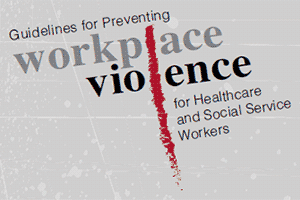
Despite several unfortunate and tragic instances in the news recently, workplace violence rates as a whole have been declining. According to the National Council on Compensation Insurance (NCCI) in its 2012 research brief Violence in the Workplace, the rates of workplace violence for both homicides and assaults have dropped. From 1993 to 2009, workplace homicides fell 59% and workplace assaults declined 37%.
However, while the share of workplace injuries caused by assaults compared to overall workplace injuries is small, it is increasing – with the healthcare profession particularly at risk. NCCI reports, from 1999 to 2009, total lost time work injuries fell by 43%, but workplace assaults declined only 7%.
No industry is at bigger risk for workplace assaults than the healthcare industry – four times greater than other professions, according to the Occupational Safety and Health Administration (OSHA). Consider:
- In November 2014, a 68-year-old patient in Minnesota went on a rampage with a metal bar and injured four nurses, two of which were hospitalized, one with a collapsed lung.
- In September 2015, a hospital patient in South Carolina was arrested after assaulting 14 nurses and staff members including striking victims with closed fists, throwing and swinging objects at staff and grabbing one female victim by the hair and throwing her to the ground.
NCCI data indicates nearly two-thirds of all workplace assaults occur in the health services industry. Healthcare support personnel, including nursing and home health aides, are the occupation most at risk for a workplace assault, followed by healthcare practitioners and technicians. And a vast majority of these assaults are to female employees.
According to NCCI, the highest incident rates within the healthcare industry are in psychiatric and substance abuse hospitals with 75 assaults per 10,000 workers in 2009, followed by other residential care facilities (44.2), intellectual disabilities, mental health and substance abuse residential facilities (38.5) and nursing care and community care facilities for the elderly (15.7 and 13.1 respectively).
These reported incident rates are likely lower than the actual totals occurring, as studies have shown many patient assaults on healthcare workers go unreported. Reasons given for failure to report incidents of assault include managerial attitudes toward incident reporting, concern the incident would upset or anger loved ones of the patient, a feeling that the aggressive behavior was mitigated by the situation, the impact of the assault was relatively mild or inexperience of the healthcare victim.
The healthcare industry itself is growing substantially in some of the areas which present the most significant risk for workplace assaults. For example, as the baby boomer generation ages, the demand for nursing care and community care facilities for the elderly will continue to increase. According to the Administration for Community Living of the U.S. Department of Health and Human Services, The population 65 and over has increased from 35.5 million in 2002 to 43.1 million in 2012 (a 21% increase) and is projected to more than double to 92 million in 2060. By 2040, there will be about 79.7 million older persons, more than twice their number in 2000. A significantly higher population of older patients needing temporary hospitalization or assisted living or nursing home care may lead to more incidents of assault against a growing pool of healthcare workers.
Several states have passed laws making an assault on a healthcare worker a felony. OSHA publishes guidelines for preventing workplace injuries in the healthcare industry, however, there are no federal requirements and most states do not have provisions for incident reporting or violence prevention training. Healthcare facilities can be proactive. As noted by Ann Gaffey, Sedgwick’s SVP for Healthcare Risk Management, “Workplace violence in all healthcare settings continues to be a top concern for risk managers. These events, including more recent activity seen around the country with active shooters, require attention at all levels of an organization. The enterprise approach to mitigating these risks has never been more critical, with a need to involve all levels of staff in response planning, training, regular drills and debriefing activities. One resource we frequently suggest to our clients is the free Centers for Disease Control and Prevention (CDC) online course for Workplace Violence Prevention for Nurses.”
Healthcare facilities have significant opportunities to develop and implement a workplace violence prevention program. For hospitals accredited by The Joint Commission (TJC), they are surveyed against the standards expected to be met to achieve compliance. One resource offered by TJC is their Sentinel Event Alert, Issue 45: Preventing violence in the health care setting, published in 2010. Additional initiatives to minimize the risk of patient assaults on healthcare workers include (but are certainly not limited to):
- Avoiding a culture of “violence is just part of the job.” Although patient care can involve a variety of risk factors that can contribute to patients becoming violent – drug or alcohol intoxication, mental or emotional instability, dementia – violence should not be the expectation in the industry.
- Creating a culture which values reporting of all incidents of assault.
- Having an active health and safety committee to review incidents of assault and make appropriate recommendations. The committee should include members from management and representation from employees working with patients in various departments.
- Establishing a violence prevention program including training for new employees and periodic refresher training for existing employees.
- Developing a comprehensive hazard prevention program. Such a program would need to be specific to the health services provided and the particular facility. The OSHA guidelines provide excellent information for the customization of such a program.
- Adapting and utilizing a workplace violence program checklist. The OSHA guidelines contain sample documents.
Although the risk of patient assaults on healthcare workers may never be eliminated, implementing the above recommendations and other initiatives should help reduce the incidents of workplace violence in the healthcare industry and reduce the share of work-related injuries represented by assaults.
Joe Daly
Sedgwick
Director Technical Performance